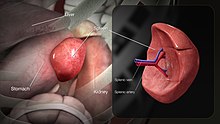
Back Milt Afrikaans Mielsa AN طحال Arabic ܛܚܠܐ ARC Bazu AST КъечӀчӀ AV Dalaq Azerbaijani Селязёнка Byelorussian Каса (анатомія) BE-X-OLD Слезка Bulgarian
| Spleen | |
|---|---|
 Position of the human spleen | |
| Details | |
| System | Immune system (lymphatic system) |
| Artery | Splenic artery |
| Vein | Splenic vein |
| Nerve | Splenic plexus |
| Identifiers | |
| Latin | splen, lien |
| MeSH | D013154 |
| TA98 | A13.2.01.001 |
| TA2 | 5159 |
| FMA | 7196 |
| Anatomical terminology | |

The spleen is an organ found in almost all vertebrates. Similar in structure to a large lymph node, it acts primarily as a blood filter. The word spleen comes from Ancient Greek σπλήν (splḗn).[1]
The spleen plays very important roles in regard to red blood cells (erythrocytes) and the immune system.[2] It removes old red blood cells and holds a reserve of blood, which can be valuable in case of hemorrhagic shock, and also recycles iron. As a part of the mononuclear phagocyte system, it metabolizes hemoglobin removed from senescent red blood cells. The globin portion of hemoglobin is degraded to its constitutive amino acids, and the heme portion is metabolized to bilirubin, which is removed in the liver.[3][4]
The spleen houses antibody-producing lymphocytes in its white pulp and monocytes which remove antibody-coated bacteria and antibody-coated blood cells by way of blood and lymph node circulation. These monocytes, upon moving to injured tissue (such as the heart after myocardial infarction), turn into dendritic cells and macrophages while promoting tissue healing.[5][6][7] The spleen is a center of activity of the mononuclear phagocyte system and is analogous to a large lymph node, as its absence causes a predisposition to certain infections.[8][4]
In humans, the spleen is purple in color and is in the left upper quadrant of the abdomen.[3][9] The surgical process to remove the spleen is known as a splenectomy.
- ^ Liddell, Henry George; Scott, Robert (1940). "σπλήν". In Jones, Henry Stuart; McKenzie, Roderick (eds.). A Greek-English Lexicon. Vol. 2: λ–φώδης (New (9th) ed.). Oxford: Clarendon Press. p. 1628. OCLC 13606128 – via Perseus Digital Library.
- ^ Kapila, Vaishali; Wehrle, Chase J.; Tuma, Faiz (2022), "Physiology, Spleen", StatPearls, Treasure Island, FL: StatPearls Publishing, PMID 30725992, retrieved 2022-12-04
- ^ a b Mebius, RE; Kraal, G (2005). "Structure and function of the spleen". Nature Reviews. Immunology. 5 (8): 606–16. doi:10.1038/nri1669. PMID 16056254. S2CID 3258595.
- ^ a b Sahin, NE; Oner, Z; Oner, S; Turan, MK (10 January 2022). "A study on the correlation between spleen volume estimated via cavalieri principle on computed tomography images with basic hemogram and biochemical blood parameters". Anatomy & Cell Biology. 55 (1): 40–47. doi:10.5115/acb.21.177. PMC 8968228. PMID 35000931.
- ^ Cite error: The named reference
Swirskiwas invoked but never defined (see the help page). - ^ Jia, T; Pamer, EG (2009). "Immunology: Dispensable but not irrelevant". Science. 325 (5940): 549–50. Bibcode:2009Sci...325..549J. doi:10.1126/science.1178329. PMC 2917045. PMID 19644100.
- ^ "Finally, the Spleen Gets Some Respect" By Natalie Angier, The New York Times, August 3, 2009
- ^ Brender, Erin (2005-11-23). Richard M. Glass (ed.). "Spleen Patient Page". Journal of the American Medical Association. 294 (20). Illustrated by Allison Burke: 2660. doi:10.1001/jama.294.20.2660. PMID 16304080.
- ^ Loscalzo, Joseph; Fauci, Anthony S.; Braunwald, Eugene; Dennis L. Kasper; Hauser, Stephen L; Longo, Dan L. (2008). Harrison's principles of internal medicine. McGraw-Hill Medical. ISBN 978-0-07-146633-2.
© MMXXIII Rich X Search. We shall prevail. All rights reserved. Rich X Search